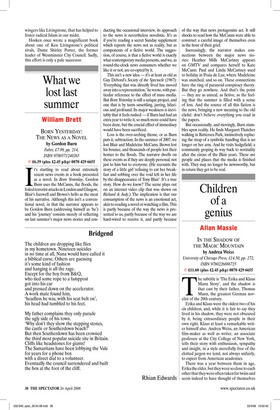A working-class villain
Leo McKinstry
KEN: THE UPS AND DOWNS OF KEN LIVINGSTONE by Andrew Hosken Arcadia Books, £15.99, pp. 435, ISBN 9781905147724 ✆ £12.79 (plus £2.45 p&p) 0870 429 6655 One of Margaret Thatcher’s more bizarre achievements during her premiership was to have transformed Ken Livingstone from municipal hate figure into popular folk hero. When she embarked on her campaign in the mid-Eighties to abolish the Greater London Council because of its perceived inefficiencies, Ken Livingtone, the GLC’s leader, was probably the most despised politician in Britain, reviled for his infantile gesture politics, extravagance with public money and noisy support for violent Irish Republicanism. But the saga of GLC abolition completely altered his image. He was no longer the town hall Trot, the moustachioed Marxist, but the people’s champion battling against the wicked Tories bent on the destruction of local democracy.
Yet, for all his public appeal, Livingstone was left in the political wilderness by the GLC’s demise in 1986. He had once dreamt of becoming Labour leader, even Prime Minister, but, having been elected to Parliament in 1987, he remained a lonely backbencher for more than a decade. It was Tony Blair who revived his political fortunes by creating the post of London Mayor, a rich irony in that Blair loathed Livingstone almost as much as Thatcher did. Blair’s des perate attempts to stop Livingstone filling the new post, including even expelling him from the Labour Party, were to no avail. ‘As I was saying before I was rudely interrupted 14 years ago,’ said Livingstone on his election as Mayor in 2000, returning to take charge of the capital’s governance.
Livingstone’s volatile personality and stormy political career, which now stretches back almost four decades to his early years as a Lambeth councillor, should have made a fascinating biography. His tale has all the right ingredients for a gripping read, including endless controversy in the public arena and turbulence in the private. BBC reporter Andrew Hosken has certainly done a thorough job, conducting over 200 interviews for the book and mastering the alphabet soup of hard-Left-wing sectarian politics in London. His labours have unearthed some intriguing material, including the revelation that Livingstone has fathered five children by three different women, though Hosken refuses to provide any details about these fluid domestic arrangements. More disturbing is the account of Livingstone’s long-term involvement with the loathsome Workers Revolutionary Party, whose leader Gerry Healy was a vile demagogue, bully, liar, rapist, drunk and fraudster. Through diligent research, Hosken provides damning evidence that Livingstone’s radical newsletter of the early Eighties, Labour Herald, was printed by the WRP when the group was bankrolled by the Libyan regime of Colonel Gadaffi. Absurdly, when Gerry Healy was exposed by his own WRP members for his monstrous reign of abuse, Livingstone claimed the whole affair was nothing more than a conspiracy by MI5.
Hosken further highlights Livingstone’s closeness to the tiny, secretive outfit Socialist Action, a Marxist cell whose members now dominate the higher echelons of City Hall in London. One of the more sinister aspects of Livingstone’s rise the top is the way he has consistently manipulated political structures for his own ends. For all his ‘Cuddly Ken’ image, he is actually a ruthless operator, willing to ditch anyone who stands in his way. ‘I love plotting’, he once said.
But such revelations cannot disguise the somewhat pedestrian tone of the book. Hosken dutifully covers all the important episodes of Livingstone’s story, but without much verve or vibrancy. For a biography of a character as explosive as Livingstone, there are surprisingly few juicy anecdotes, hardly anything, for instance, about his renowned fondness for the bedroom or the drinks cabinet. Throughout the text, there is a sense of punches being pulled, perhaps because the author felt inhibited by the fulsome co-operation that Livingstone gave him. At times, Hosken seems far too generous. He frequently describes Livingstone as ‘sensitive’, though what he really means is that Livingstone is prickly and egocentric. In one almost laughable passage, Hosken claims that Livingstone inherited his ‘oldfashioned values’ of ‘politeness and compassion’ from growing up in a working-class household in Lambeth in the Fifties. In truth, Livingstone’s career has often seemed like a permanent adolescent rebellion against the well-ordered British civilisation of the post-war era. And ‘politeness’ and ‘compassion’ are the last words to describe Livingstone’s hysterical abuse of colleagues on the Greater London Authority or his anti-Semitic ranting against a Jewish reporter from the Evening Standard, whom he compared to a Nazi concentration camp guard. Livingstone would never had dreamt of calling a black journalist a slave owner.
Lavishing praise on Livingstone over the congestion charge or the successful Olympic bid, Hosken has little to say about the vast empire of sleaze and wasteful expenditure that Livingstone has created at City Hall. The book also fails to challenge Livingstone’s stance that, after the July bombings in 2005, the ‘most important’ task was to ‘prevent a breakdown in community cohesion’, this to be done through lavish spending on anti-racism campaigns. Some would argue that it is precisely this ideological attachment to multi-cultural diversity, so eagerly promoted by left wingers like Livingstone, that has helped to foster radical Islam in our midst.
Hosken once wrote a magnificent book about one of Ken Livingstone’s political rivals, Dame Shirley Porter, the former leader of Westminster City Council. Sadly, this effort is only a pale successor.











































































 Previous page
Previous page